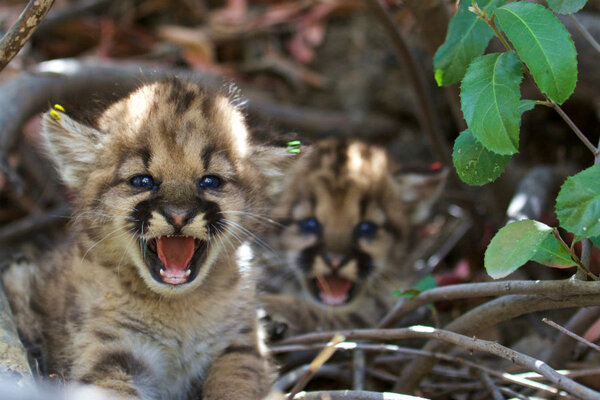https://www.google.com/url?rct=j&sa=t&url=http://www.csmonitor.com/Environment/2016/0707/Mountain-lion-kittens-found-near-Los-Angeles-are-an-adorable-find&ct=ga&cd=CAEYACoTNjE2ODQxODkxNDU4Mzg1NTMyNjIaNDY5MjBhOTZlZmMxMTU4ODpjb206ZW46VVM&usg=AFQjCNGzipISNyXty0Ty_EEHFOzkAEH6tw
Mountain lion kittens found near Los Angeles are an adorable find
Five kittens were found in two dens in the the Santa Susana Mountains.
The National Park Service is busy making cat videos.
Researchers from the Park Service found two separate
litters of mountain lion kittens living in the Santa
Susana Mountains north of Los Angeles. The NPS has
released videos of the kittens, which the service
tagged as part of a study into how mountain lions
are affected by human infrastructure in and around
Los Angeles.
litters of mountain lion kittens living in the Santa
Susana Mountains north of Los Angeles. The NPS has
released videos of the kittens, which the service
tagged as part of a study into how mountain lions
are affected by human infrastructure in and around
Los Angeles.
The lions appear to be reproducing successfully,
according to wildlife biologist Jeff Sikich, but the
threats will pile up as the kittens age, he told the
Los Angeles Times.
according to wildlife biologist Jeff Sikich, but the
threats will pile up as the kittens age, he told the
Los Angeles Times.
“The real challenge comes as these
kittens grow older and disperse,
especially the males, and have to
deal with threats from other
mountain lions, road mortality,
and the possibility of poisoning
from anticoagulant rodenticide,
” he said.
About 50 percent of California is considered
a potential habitat for mountain lions, which
have come a long way in the last century.
Considered a threat to animal husbandry
because of their habit of picking off livestock,
they were declared a “bountied predator”
in 1907, with a $20 incentive offered for
each one killed. In 1919, the state even hired
a pair of full-time hunters, adding trappers
and two more hunters to their payroll in
subsequent decades.One litter has two
female kittens born to a mother tagged
as P-35. The other litter contains two males
and a female, born to mother P-39. Both
litters are believed to have the same
father, P-38.
a potential habitat for mountain lions, which
have come a long way in the last century.
Considered a threat to animal husbandry
because of their habit of picking off livestock,
they were declared a “bountied predator”
in 1907, with a $20 incentive offered for
each one killed. In 1919, the state even hired
a pair of full-time hunters, adding trappers
and two more hunters to their payroll in
subsequent decades.One litter has two
female kittens born to a mother tagged
as P-35. The other litter contains two males
and a female, born to mother P-39. Both
litters are believed to have the same
father, P-38.
In the 1960s, as protectionist feeling
began to spread among a greater portion
of the public, the bounty program ended,
and the lions began gaining protections
that culminated in a moratorium on
hunting them in 1990.
began to spread among a greater portion
of the public, the bounty program ended,
and the lions began gaining protections
that culminated in a moratorium on
hunting them in 1990.
That moratorium, still in effect, has
helped the population grow from an
estimated 2,000 in the 1970s to between
4,000 and 6,000 at present, according
to the California Department of Fish
and Game Services. The lions are not
considered threatened or endangered
in the state, so while there is no season
on the big cats, about 60 are legally killed
each year with depredation permits, plus
others killed for posing a threat to humans
or endangered bighorn sheep.
helped the population grow from an
estimated 2,000 in the 1970s to between
4,000 and 6,000 at present, according
to the California Department of Fish
and Game Services. The lions are not
considered threatened or endangered
in the state, so while there is no season
on the big cats, about 60 are legally killed
each year with depredation permits, plus
others killed for posing a threat to humans
or endangered bighorn sheep.
In some parts of California,
particularly in towns adjoining
rural areas, run-ins with the
big cats aren’t uncommon. In
February, the San Francisco
Chronicle reported that a
Department of Fish and Wildlife
study had found that of the 107
mountain lions legally killed
last year, almost half had traces o
f cats, dogs, and other domestic
animals in their stomachs.
particularly in towns adjoining
rural areas, run-ins with the
big cats aren’t uncommon. In
February, the San Francisco
Chronicle reported that a
Department of Fish and Wildlife
study had found that of the 107
mountain lions legally killed
last year, almost half had traces o
f cats, dogs, and other domestic
animals in their stomachs.
The National Park Service researchers
who found the new litters say they identified
the father by using GPS tracking data.
who found the new litters say they identified
the father by using GPS tracking data.











No comments:
Post a Comment